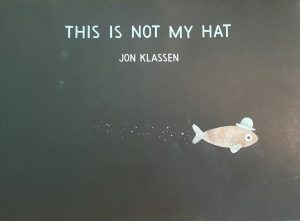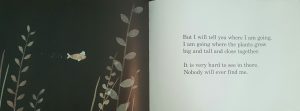

Title: This Is Not My Hat
Author: Jon Klassen
Illustrator: Jon Klassen
Publishers and Year: Candlewick, 2012
Number of pages: 32
Genre: Fiction
This Is Not My Hat tells the story of a fish’s attempt to steal another fish’s hat. The thief fish hides with the assumption that the victim fish will not be able to find him. However, in the end the victim fish finds the thief and takes back his hat.
This book is an excellent example of literature functioning as both a mirror and as a window. It is an example of a mirror because it gives the reader an opportunity to see their own thought process/perspectives in the thief fish. Any reader can relate to the thief fish because people, in general, are often naive in thinking that things done in secret will remain hidden. The text of this book takes us through that perspective and allows us to connect with that thought process. The illustrations, however, provide a window for the reader to look through. The illustrations reveal the thought process and perspective of the victim fish. This perspective completely contradicts the text and leaves us with pictures that tell an entirely different story. This contradiction provides the window that allows the reader to understand an outside perspective.
Another method used to depict this was the intentionality of the illustrations. Although one might think that the thief would carry more power, the readers see the opposite portrayed in the illustrations. Rather, the readers notice that the victim is drawn significantly larger than the thief. I believe this was intentionally done to show that the power actually lies in honesty. The small fish felt and acted powerful in his attempts. However, he was continually swimming towards confinement (the place where leaves are close together) where the truly powerful fish would find him before swimming back into the ocean. Overall, the author did a phenomenal job of using contradictory text and illustrations to speak into the turmoil children might experience when deciding between right and wrong. Allowing children to see their own emotions and thought process as well as the outside perspective connects them to the world around them in a new way. It helps to erase the naivety and smallness of thinking people can get into.
The contradicting text and illustrations speak loudly in this text. The author/illustrator did a phenomenal job balancing the two. Despite the two contradicting themes, the story follows the normal thought patterns well. The way the text is displayed and even the diction used directly influences our understanding of the story. Overall, the author conveys that the things that are hidden will always come to the light so people might as well be honest with them in the first place.
